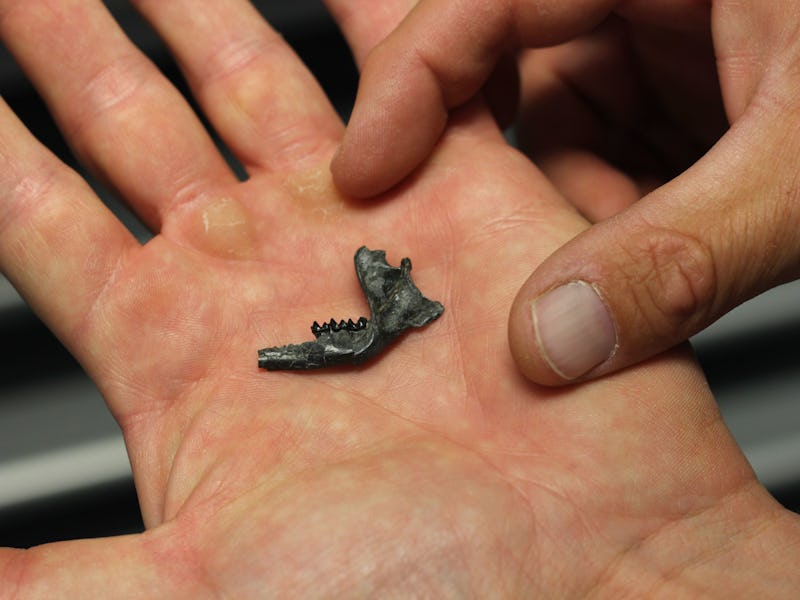These Tiny Ancient Mammals Were Tougher Than a T. Rex
Don't underestimate the little guys.

Craig Scott is working on a puzzle. Most of the pieces are gone forever, and the rest are scattered all over the world, mostly buried underground.
Scott is the curator of fossil mammals with the Royal Tyrrell Museum in Alberta Canada. His research focuses on a crucial moment in the evolution of mammals — the Cretaceous Paleogene (K-Pg) boundary, otherwise known as the mass extinction that wiped out nearly all the dinosaurs.
This was a big moment for mammals, since the void left behind by the dinosaurs left ecological niches open for survivors to come into and turn into a home. And Scott’s job is to figure out, one very small puzzle piece at a time, how exactly they did it.
“For a lot of these mammals, we don’t know anything about them except for their teeth,” he tells Inverse.
Craig Scott examines his fossil mammal collection at the Royal Tyrrell Museum.
We usually classify time by the age of dinosaurs and the age of mammals, but the truth is more complicated. Mammals and dinosaurs coexisted for tens of millions of years before the collapse of those great beasts. And modern dinosaurs — we call them birds — live on to this day.
At the end of the Cretaceous period, dinosaurs were the true rulers of the land. But the mammals were there, too, scurrying about trying to stay as inconspicuous and out of the way as possible.
Then that pesky asteroid hit, ultimately leading to the extinction of all of the non-avian dinosaurs. That time was a rough time to be alive by any standard, and mammals were hit hard, too. But in the end, those rare survivors came out on top, and the little shrew-like creatures that emerged from the rubble went on to inherit the Earth.
This tiny set of molars was found south of Calgary, Canada. The animal they belonged to lived within a million years of the extinction of the dinosaurs.
Scott has a couple ideas on how mammals did relatively well at a time of mass extinction. The rapid climate and ecosystem change at the boundary between the Cretaceous at the Paleogene meant that adaptability was a key measure of survival. Even within mammals, those that fared the best tended to be generalists, rather than specialists, with the ability to use different food sources and environments. Small body size also seemed to help, and certainly all of the largest fauna died out. When food is scarce, it’s a benefit if you need to find less of it.
But the whole story is probably much more nuanced and complicated, and certainly there are exceptions to the rule, says Scott.
In a world where teeth are the main fossil evidence, it’s exciting and enlightening to find even a piece of jaw with some teeth intact. That can help solve questions not only about that specimen, but other more scattered pieces in Scott’s collection. “It’s small mysteries that get solved over time with more information,” he says.
The fossil record for mammals around the great dinosaur extinction event is pretty slim, both because their tiny, fragile bones are less likely to be preserved, and even if they become fossilized they are much harder to find. There are also fewer people looking for them, since they lack the same cultural cachet as dinosaurs.
Within about five million of years of the K-Pg boundary, one group of mammals, the pantodonts, was experimenting with large body size. This one, small for a pantodont, would have been as big as a large dog.
There are advantages to the work, though. “The thing that I really like about collecting mammals is that it’s instant gratification,” says Scott. If you find something cool, you can take it back to the lab that same day, whereas with a large dinosaur skeleton you could be excavating for years before you even get a proper look at it.
Instant gratification in paleontology is a relative term. Four years ago, he found a partial skull and skeleton from a mammal that lived within a million years of the K-Pg boundary. That’s a real coup towards the effort of unlocking the mysteries of mammal evolution through the extinction event, but Scott won’t say too much about it. “It’s not finished being prepared yet,” he laughs. Scientists are wary of giving away too much before submitting their research to the wringer of the peer review and journal publication process.
But when he’s done with it, Scott expects this tiny animal will unlock secrets to life on Earth at a very tough time to be alive. “This critter is really quite special, because we’ve got parts of the skull, we’ve got parts of the postcranium, so we can learn not only about what this animal looked like from its dentition and what it might have been eating, but also from its postcranium, what sort of ecological niche it might have inhabited, how it moved.”
Among the tiny mammal survivors of the K-Pg extinction were the very, very distant ancestors of all humans that live today. When Scott thinks about our place in the evolution of mammals, he thinks about just how long and large that history has been. “We are but the tip of a leaf on a very, very large tree.”